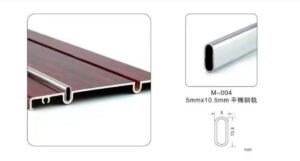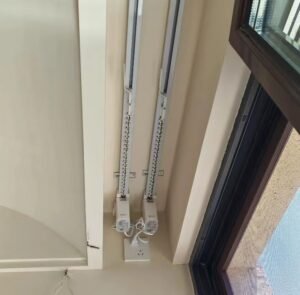Designers spend months perfecting a clean, minimalist look. But a bulky, visible curtain rod can instantly ruin the entire aesthetic, making a high-end project feel cheap and dated.
In modern design, curtain tracks are a foundational element, not an accessory. They enable minimalist aesthetics by allowing for ceiling-to-floor curtains, invisible recessed installations, and the support of heavy functional fabrics, making the window treatment an integrated part of the architecture.
I remember a conversation with Matt, an experienced Purchasing Manager in the US I've partnered with for years. He was sourcing for a new boutique hotel chain known for its minimalist design. He told me, "August, I don't want to see the track. I want the curtain to look like it's floating down from the ceiling." That's the core of modern design—making functional elements disappear. It's not just about hanging a curtain anymore; it’s about how the hanging system contributes to the overall architectural vision. Let’s dive into how these essential components make modern design possible.
Are curtain tracks more modern than rods?
You're aiming for a sleek, contemporary space, but traditional curtain rods often feel clunky and dated. They can break up clean lines and create visual clutter.
Yes, curtain tracks are inherently more modern than rods because of their discreet, minimalist profile. They blend into the ceiling or wall, allowing the focus to remain on the fabric and the architectural space, which is a key principle of modern design.
From my perspective in the factory, the design difference is clear. Curtain rods are designed to be seen; they are decorative elements with finials and prominent brackets. This is the complete opposite of the modern design ethos, which prioritizes clean lines and function. Curtain tracks, on the other hand, are engineered for performance and subtlety. Their slim, linear profile is designed to be as unobtrusive as possible. This allows architects and designers to create long, continuous spans of fabric without visual interruption from brackets. In commercial spaces like hotels or offices, where consistency and a clean aesthetic are paramount, tracks are the superior choice. They put the function first and allow the design to speak for itself, rather than adding another decorative layer.
| Feature | Curtain Tracks | Curtain Rods |
|---|---|---|
| Aesthetic | Minimalist, discreet, linear | Decorative, prominent, traditional |
| Best For | Modern, contemporary, commercial spaces | Classic, rustic, traditional homes |
| Visual Impact | Blends in, supports the overall design | Becomes a focal point itself |
| Function | Smooth operation for heavy, wide curtains | Best for standard-weight, decorative panels |
How do you hide a curtain track?
Even a slim track can interrupt a perfect ceiling line. For the ultimate minimalist look, designers demand a solution where the hardware is completely gone from sight.
To hide a curtain track, you install it as a recessed track. This involves creating a channel or "pocket" in the ceiling structure. The track is then mounted up inside this recess, making it completely invisible from the room below.
This technique is the gold standard for high-end, modern interiors, and it's something we work on directly with architects and builders during the construction phase. Planning is key. A recess, or "curtain pocket," is built into the drywall or ceiling system. Its dimensions must be precise to accommodate the track, the gliders, and the curtain header.
When done correctly, the result is magical. The curtain fabric seems to emerge directly from a neat slot in the ceiling, with no visible hardware. This method not only achieves the cleanest possible look but also enhances light-blocking capabilities, as it eliminates the top light gap entirely.
For my client Matt's minimalist hotel project, every room featured recessed tracks. He knew this single detail would communicate "luxury" and "design-forward" to every guest who walked in.
Are ceiling mounted curtain tracks better?
You need a window treatment solution that feels luxurious and maximizes the sense of space. Wall-mounted options can make ceilings feel lower and rooms feel smaller.
Yes, for modern design, ceiling-mounted tracks are almost always better. They create a seamless, floor-to-ceiling drape that makes rooms appear taller and more spacious. This technique gives a high-end, architectural feel that wall-mounted hardware cannot replicate.
The visual impact of a ceiling-mounted track is one of its strongest selling points. By taking the curtain all the way up to the ceiling line, you draw the eye upward, creating a powerful illusion of height. This is a classic designer trick to make spaces feel grander and more open. From a functional standpoint, a ceiling track is also superior for light control.
Wall-mounted rods and tracks always leave a gap between the hardware and the ceiling, allowing light to leak into the room. For a luxury hotel that promises a true blackout experience, this is unacceptable. A ceiling-mounted track, especially when paired with a small pelmet or a recessed installation, creates a complete seal at the top.
This ensures total darkness, which is a critical factor for guest satisfaction. It's a simple change in mounting that delivers a huge upgrade in both form and function.
What type of curtain track is best?
As a purchasing manager, you need to choose a track that not only looks good but also performs reliably for years under heavy commercial use. The wrong choice leads to maintenance issues and failures.
The best type of curtain track for commercial use is a heavy-duty, commercial-grade aluminum track. Look for systems with high-quality, wheeled gliders for smooth operation and a durable finish to prevent chipping and friction over time.
Having spent years on the factory floor, I can tell you that not all tracks are created equal. For commercial projects, plastic tracks are simply not an option. You need the strength and rigidity of extruded aluminum. The thickness of the aluminum profile is a key indicator of its durability and ability to span wide windows without sagging under the weight of heavy blackout or acoustic fabrics.
Beyond the material, the gliders are the most critical component for performance.
Key Glider Types to Consider:
- Wheeled Gliders: These are essential for heavy curtains. The wheels roll along the track instead of sliding, drastically reducing friction and making operation smooth and effortless.
- Friction Gliders: These are simple plastic hooks that slide. They are adequate for very light, sheer curtains but will stick and break under the strain of commercial-grade drapes.
When Matt is sourcing for a project, he always requests samples to test the glide. He knows a smooth, silent glide is the sign of a well-engineered system that will last. It's a long-term investment in operational excellence and guest satisfaction.
Conclusion
Curtain tracks are the unseen heroes of modern interior design. They provide the clean lines, seamless integration, and functional strength necessary to create sophisticated, high-performance spaces for hotels and offices.








